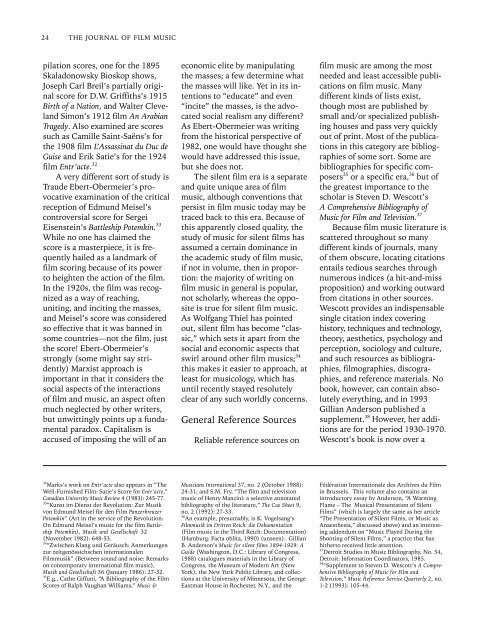Music in Films: A Critical Review of Literature - California State ...
Music in Films: A Critical Review of Literature - California State ...
Music in Films: A Critical Review of Literature - California State ...
Create successful ePaper yourself
Turn your PDF publications into a flip-book with our unique Google optimized e-Paper software.
24 THE JOURNAL OF FILM MUSIC<br />
pilation scores, one for the 1895<br />
Skaladonowsky Bioskop shows,<br />
Joseph Carl Breil’s partially orig<strong>in</strong>al<br />
score for D.W. Griffiths’s 1915<br />
Birth <strong>of</strong> a Nation, and Walter Cleveland<br />
Simon’s 1912 film An Arabian<br />
Tragedy. Also exam<strong>in</strong>ed are scores<br />
such as Camille Sa<strong>in</strong>t-Saëns’s for<br />
the 1908 film L’Assass<strong>in</strong>at du Duc de<br />
Guise and Erik Satie’s for the 1924<br />
film Entr’acte. 32<br />
A very different sort <strong>of</strong> study is<br />
Traude Ebert-Obermeier’s provocative<br />
exam<strong>in</strong>ation <strong>of</strong> the critical<br />
reception <strong>of</strong> Edmund Meisel’s<br />
controversial score for Sergei<br />
Eisenste<strong>in</strong>’s Battleship Potemk<strong>in</strong>. 33<br />
While no one has claimed the<br />
score is a masterpiece, it is frequently<br />
hailed as a landmark <strong>of</strong><br />
film scor<strong>in</strong>g because <strong>of</strong> its power<br />
to heighten the action <strong>of</strong> the film.<br />
In the 1920s, the film was recognized<br />
as a way <strong>of</strong> reach<strong>in</strong>g,<br />
unit<strong>in</strong>g, and <strong>in</strong>cit<strong>in</strong>g the masses,<br />
and Meisel’s score was considered<br />
so effective that it was banned <strong>in</strong><br />
some countries—not the film, just<br />
the score! Ebert-Obermeier’s<br />
strongly (some might say stridently)<br />
Marxist approach is<br />
important <strong>in</strong> that it considers the<br />
social aspects <strong>of</strong> the <strong>in</strong>teractions<br />
<strong>of</strong> film and music, an aspect <strong>of</strong>ten<br />
much neglected by other writers,<br />
but unwitt<strong>in</strong>gly po<strong>in</strong>ts up a fundamental<br />
paradox. Capitalism is<br />
accused <strong>of</strong> impos<strong>in</strong>g the will <strong>of</strong> an<br />
32 Marks’s work on Entr’acte also appears <strong>in</strong> “The<br />
Well-Furnished Film: Satie’s Score for Entr’acte,”<br />
Canadian University <strong>Music</strong> <strong>Review</strong> 4 (1983): 245-77.<br />
33 “Kunst im Dienst der Revolution: Zur Musik<br />
von Edmund Meisel für den Film Panzerkreuzer<br />
Potemk<strong>in</strong>” (Art <strong>in</strong> the service <strong>of</strong> the Revolution:<br />
On Edmund Meisel’s music for the film Battleship<br />
Potemk<strong>in</strong>), Musik und Gesellschaft 32<br />
(November 1982): 648-53.<br />
34 “Zwischen Klang und Geräusch: Anmerkungen<br />
zur zeitgenössichschen <strong>in</strong>ternationalen<br />
Filmmusik” (Between sound and noise: Remarks<br />
on contemporary <strong>in</strong>ternational film music),<br />
Musik und Gesellschaft 36 (January 1986): 27-32.<br />
35 E.g., Cathe Giffuni, “A Bibliography <strong>of</strong> the Film<br />
Scores <strong>of</strong> Ralph Vaughan Williams,” <strong>Music</strong> &<br />
economic elite by manipulat<strong>in</strong>g<br />
the masses; a few determ<strong>in</strong>e what<br />
the masses will like. Yet <strong>in</strong> its <strong>in</strong>tentions<br />
to “educate” and even<br />
“<strong>in</strong>cite” the masses, is the advocated<br />
social realism any different?<br />
As Ebert-Obermeier was writ<strong>in</strong>g<br />
from the historical perspective <strong>of</strong><br />
1982, one would have thought she<br />
would have addressed this issue,<br />
but she does not.<br />
The silent film era is a separate<br />
and quite unique area <strong>of</strong> film<br />
music, although conventions that<br />
persist <strong>in</strong> film music today may be<br />
traced back to this era. Because <strong>of</strong><br />
this apparently closed quality, the<br />
study <strong>of</strong> music for silent films has<br />
assumed a certa<strong>in</strong> dom<strong>in</strong>ance <strong>in</strong><br />
the academic study <strong>of</strong> film music,<br />
if not <strong>in</strong> volume, then <strong>in</strong> proportion:<br />
the majority <strong>of</strong> writ<strong>in</strong>g on<br />
film music <strong>in</strong> general is popular,<br />
not scholarly, whereas the opposite<br />
is true for silent film music.<br />
As Wolfgang Thiel has po<strong>in</strong>ted<br />
out, silent film has become “classic,”<br />
which sets it apart from the<br />
social and economic aspects that<br />
swirl around other film musics; 34<br />
this makes it easier to approach, at<br />
least for musicology, which has<br />
until recently stayed resolutely<br />
clear <strong>of</strong> any such worldly concerns.<br />
General Reference Sources<br />
Reliable reference sources on<br />
<strong>Music</strong>ians International 37, no. 2 (October 1988):<br />
24-31; and S.M. Fry, “The film and television<br />
music <strong>of</strong> Henry Manc<strong>in</strong>i: a selective annotated<br />
bibliography <strong>of</strong> the literature,” The Cue Sheet 9,<br />
no. 2 (1992): 27-33.<br />
36 An example, presumably, is K. Vogelsang’s<br />
Filmmusik im Dritten Reich: die Dokumentation<br />
(Film music <strong>in</strong> the Third Reich: Documentation)<br />
(Hamburg: Facta oblita, 1990) (unseen). Gillian<br />
B. Anderson’s <strong>Music</strong> for silent films 1894-1929: A<br />
Guide (Wash<strong>in</strong>gton, D.C.: Library <strong>of</strong> Congress,<br />
1988) catalogues materials <strong>in</strong> the Library <strong>of</strong><br />
Congress, the Museum <strong>of</strong> Modern Art (New<br />
York), the New York Public Library, and collections<br />
at the University <strong>of</strong> M<strong>in</strong>nesota, the George<br />
Eastman House <strong>in</strong> Rochester, N.Y., and the<br />
film music are among the most<br />
needed and least accessible publications<br />
on film music. Many<br />
different k<strong>in</strong>ds <strong>of</strong> lists exist,<br />
though most are published by<br />
small and/or specialized publish<strong>in</strong>g<br />
houses and pass very quickly<br />
out <strong>of</strong> pr<strong>in</strong>t. Most <strong>of</strong> the publications<br />
<strong>in</strong> this category are bibliographies<br />
<strong>of</strong> some sort. Some are<br />
bibliographies for specific composers<br />
35 or a specific era, 36 but <strong>of</strong><br />
the greatest importance to the<br />
scholar is Steven D. Wescott’s<br />
A Comprehensive Bibliography <strong>of</strong><br />
<strong>Music</strong> for Film and Television. 37<br />
Because film music literature is<br />
scattered throughout so many<br />
different k<strong>in</strong>ds <strong>of</strong> journals, many<br />
<strong>of</strong> them obscure, locat<strong>in</strong>g citations<br />
entails tedious searches through<br />
numerous <strong>in</strong>dices (a hit-and-miss<br />
proposition) and work<strong>in</strong>g outward<br />
from citations <strong>in</strong> other sources.<br />
Wescott provides an <strong>in</strong>dispensable<br />
s<strong>in</strong>gle citation <strong>in</strong>dex cover<strong>in</strong>g<br />
history, techniques and technology,<br />
theory, aesthetics, psychology and<br />
perception, sociology and culture,<br />
and such resources as bibliographies,<br />
filmographies, discographies,<br />
and reference materials. No<br />
book, however, can conta<strong>in</strong> absolutely<br />
everyth<strong>in</strong>g, and <strong>in</strong> 1993<br />
Gillian Anderson published a<br />
supplement. 38 However, her additions<br />
are for the period 1930-1970.<br />
Wescott’s book is now over a<br />
Fédération Internationale des Archives du Film<br />
<strong>in</strong> Brussels. This volume also conta<strong>in</strong>s an<br />
<strong>in</strong>troductory essay by Anderson, “A Warm<strong>in</strong>g<br />
Flame – The <strong>Music</strong>al Presentation <strong>of</strong> Silent<br />
<strong>Films</strong>” (which is largely the same as her article<br />
“The Presentation <strong>of</strong> Silent <strong>Films</strong>, or <strong>Music</strong> as<br />
Anaesthesia,” discussed above) and an <strong>in</strong>terest<strong>in</strong>g<br />
addendum on “<strong>Music</strong> Played Dur<strong>in</strong>g the<br />
Shoot<strong>in</strong>g <strong>of</strong> Silent <strong>Films</strong>,” a practice that has<br />
hitherto received little attention.<br />
37 Detroit Studies <strong>in</strong> <strong>Music</strong> Bibliography, No. 54,<br />
Detroit: Information Coord<strong>in</strong>ators, 1985.<br />
38 “Supplement to Steven D. Wescott’s A Comprehensive<br />
Bibliography <strong>of</strong> <strong>Music</strong> for Film and<br />
Television,” <strong>Music</strong> Reference Service Quarterly 2, no.<br />
1-2 (1993): 105-44.

















